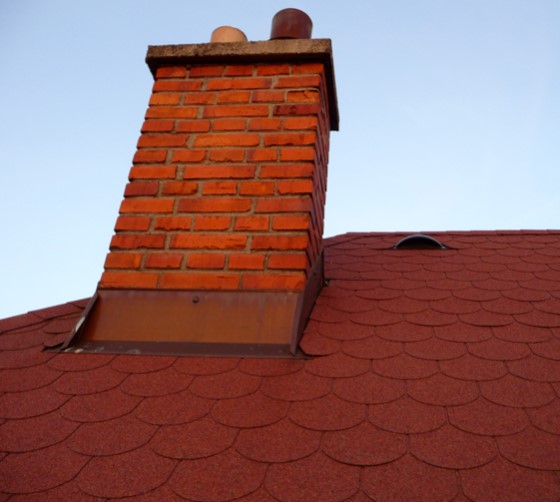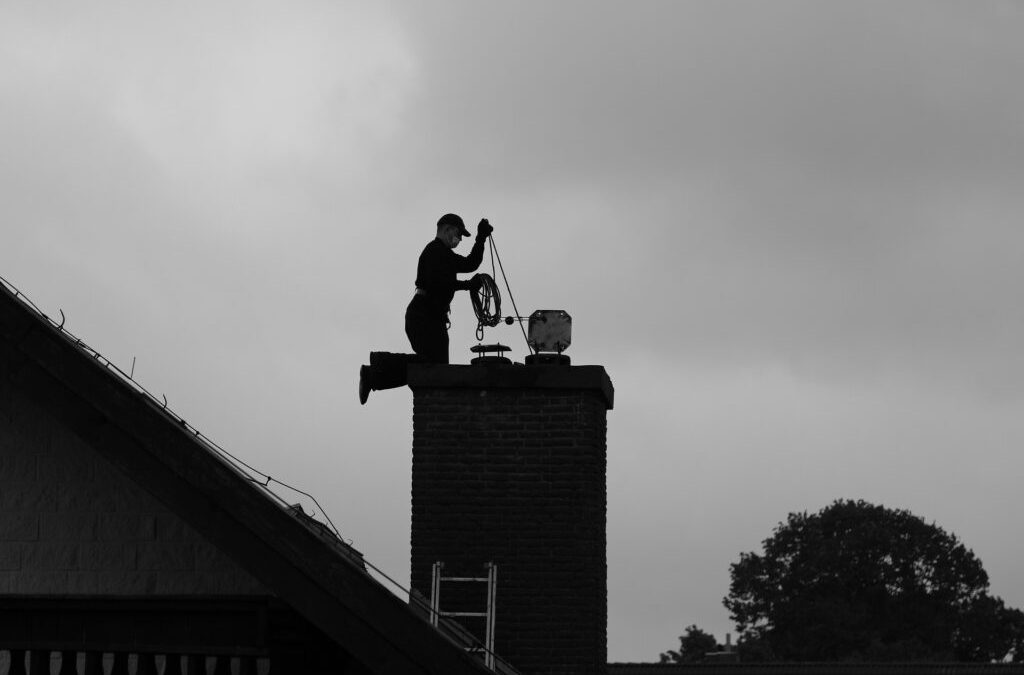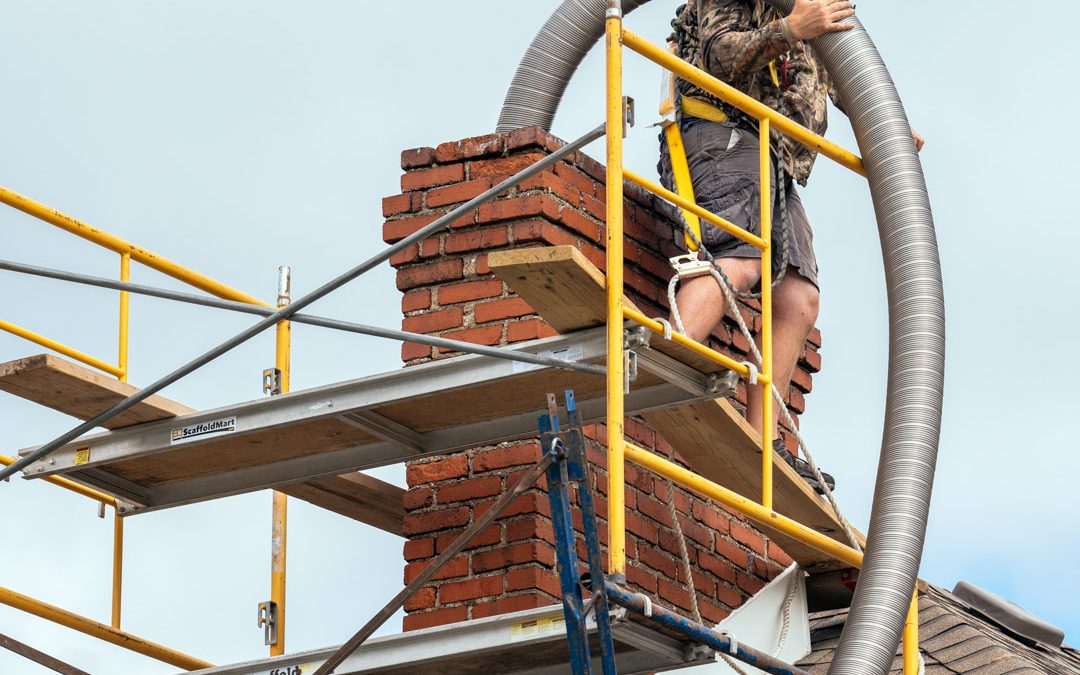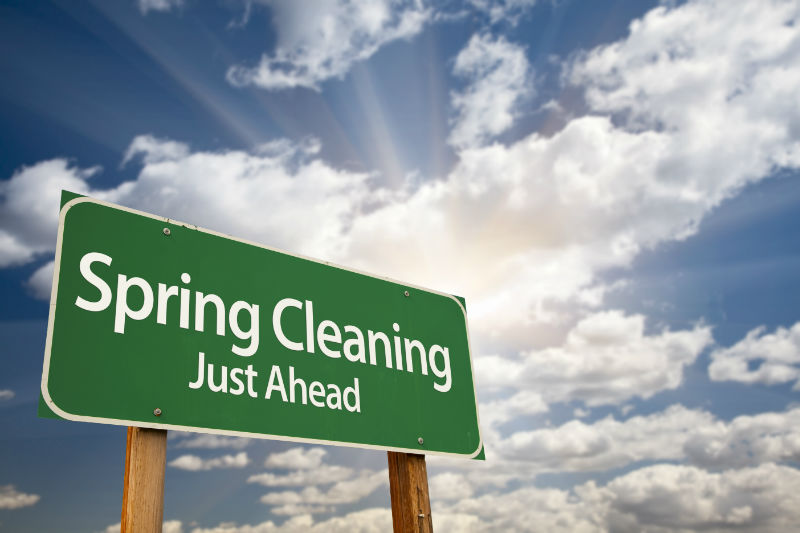
by sunshine | Jul 25, 2024 | Mercer County Chimney Sweep
Ash – The white/grey powdery residue left when combustible materials such as wood and coal is burned.
Ash Dump – An opening located at the bottom of the fireplace, through which ashes can be dumped. Often, there is a door covering the opening than can be open and shut.
Ash Pit – A storage compartment for ashes, located underneath the ash dump. It is usually quite large and should have a access door for cleaning out the ashes periodically.
Baffle – An object or plate installed in an stove or fireplace to change the direction of flue gases often to help burn more effectively.
Blower – A fan with a motor that is often installed in a fireplace or stove to help distribute the heat being produced.
Carbon Monoxide – An odorless, colorless, tasteless poisonous gas that is a byproduct of incomplete combustion. Carbon monoxide can be fatal if not detected.
Chimney Chase – The area or structure around metal flue pipes. The chase is usually built with wood or steel studs with an exterior that can include brick/stone veneer or wood siding or stucco
Chimney – One or more passageways, vertical or nearly so for conveying flue gases from the appliance to the outside atmosphere.
Chimney (or Flue) Cap – A protective covering or housing for the top of a chimney. Often, chimney caps have a lid to protect from rain, snow and sleet and a screen mesh of some sort to keep animals out.
Chimney Cleaning (Sweeping) – The process of removing soot, creosote, and debris from a chimney. Soot and creosote are by-products of combustion and should be removed regularly from the chimney to help prevent a chimney fire. Chimney cleaning along with an inspection should be performed as part of an maintenance schedule to ensure your chimney operates as efficiently and safely as possible.
Chimney Connector – The pipe connecting a fuel-burning appliance to a chimney. Most commonly made from galvanized steel, stove black pipe, or a listed double-wall pipe system.
Chimney Liner – The inner portion of the chimney that contains the products of combustion. It can be made of clay tiles or of metal. The flue chimney liner is one of the most important part of the chimney system. It must be able to contain the products of the combustion process. This means that any holes, cracks or deteriorations must be repaired or replaced to ensure the performance and safety of the chimney system.
Creosote – Deposits of hydrocarbons that were in the smoke going up the chimney that have condensed into a solid form.
Cricket – (also referred to as a Saddle) A ridge that extends from the back of the chimney to the slope of the roof, with the purpose of shedding water away from the connection between the chimney and the roof.
Crown – A chimney crown (or cap) is the top surface of a chimney designed to shed water away from the flue liner and protect the masonry from water leakage. Often times, the crown should be made of concrete and should have a slope away from the center of the flue stacks.
Damper – A damper is a device for controlling the flow of air or smoke in a chimney or woodstove. In its most common form, plates are located in the fireplace or stove pipe with a control handle. For some stoves there is an additional air control damper located on the exterior of the stove.
Draft – The rising gas creates a pressure difference called draft, which draws combustion air into the appliance and expels the exhaust gas outside through the chimney.
Dryer Vent Cleaning – Lint that normally occurs in a clothes dryer can build up over time. Build-up of lint causes the dryer to take more time in drying the standard load of clothes and becomes a fire hazard. Dryer vent cleaning is a service in which the built up lint is removed from the dryer venting systems.
Firebox – Chamber of a fireplace or stove where the fire actually burns.
Firebrick – Brick composed of clay and silica and designed to withstand high temperatures such as those found in a firebox.
Fireplace Inserts – Wood, coal, pellets, or gas heating appliances that fit inside an existing fireplace.
Flashing – Sheet metal or other materials used in waterproofing roof valleys or the angle between a chimney and a roof.
Flue – The passage in a chimney for conveying flue gases to the outside atmosphere.
Flue Liner – Special liner required by codes and standards to cover the inner surface of the flue. The liner serves as a buffer between flue gases and chimney walls and is designed to contain the products of combustion.
Hearth – Floor area within the firebox of a fireplace or a fireplace stove.
Hearth Extension – The structure, usually consisting of stone, masonry or tile that protrudes in the living area of the house.
Masonry Chimney – A field-constructed chimney of bricks, stones or reinforced Portland cement concrete, lined with suitable chimney flue liners built in accordance with applicable building code requirements.
Masonry Fireplace – A hearth and firebox of solid masonry units such as bricks, stones, listed masonry units, or reinforced concrete, provided with a suitable chimney.
Multi-flue Chimney – A single chimney containing more than one flue.
Pellets – Small balls or blocks made of wood sawdust with no additives.
Parging – A thin coat of mortar applied to the inside of a masonry chimney or to the walls of a smoke chamber designed to reduce the resistance of flow in the chimney system.
Pyrolysis – Chemical alteration of wood, coal, or other combustible materials as a result of the application of heat.
Smoke Chamber – Chamber in a fireplace directly above the smoke shelf and extending to the base of the flue.
Smoke Shelf – The area at the bottom of the smoke chamber created as the back wall of the firebox arches forward. The shelf is located at the intersection of the smoke chamber and the firebox. A damper is normally located on the forward side of the smoke shelf.
Stainless Steel Liners – Stainless steel pipe, either rigid or flexible, made for relining flues of masonry chimneys when the original clay liner has cracked or broken. May also be used to create a lining in a masonry chimney that was made without a clay liner.
Soot – Soft, black, or brown, velvety carbon particle deposits inside appliances, chimneys or connectors, originating in oxygen-poor flames.
Stack Effect – The tendency for warmer air to rise within a structure, creating lower pressure in the lower areas of the building.
Thermal Expansion – Alteration to temperature inside a chimney or duct system that causes the metal surfaces to expand.
Thimble – Fixed or removable ring, tube, or lining usually located in the hole where the chimney connector passes through a wall and enters a chimney or vent.
Throat – Opening above a fireplace firebox through which flue gases pass from the firebox to the flue. The fireplace damper frame assembly is usually located at the throat of a fireplace.
Vent – A continuous passage from the flue collar to the draft hood. Flue gas temperatures at the outlet do not exceed 600 degrees.
Video Scan – Incorporating a closed circuit video camera and monitor, for inspecting the interior of flues and other inaccessible areas. This provides a very detailed part of the inspection process.
Woodstoves – Enclosed appliances, most commonly constructed of steel or cast-iron, used for burning wood for the purpose of heating an indoor space.
Contact us
If our CSIA Certified Chimney Sweep determines that your chimney needs swept, we will take the utmost care to keep your living space completely clean. Proudly Serving Mercer County, Somerset County, Hunterdon County, & Surrounding Areas.
St John Chimney Sweeps Address 1613 Reed Rd D1, Pennington, NJ 08534
Website http://www.stjohnchimneysweeps.com/
Email: stjohnchimneysweeps@verizon.net Phone Number: (609) 737-0133
Safety chimney sweep guidelines

by sunshine | Jun 6, 2024 | Mercer County Chimney Sweep
ANNUAL INSPECTION IS A MUST
Have your chimneys inspected annually and swept if needed. If the chimney (fireplace & furnace/water heater/flue) is clean and free of obstructions, there is less danger of a chimney fire or carbon monoxide poisoning.
KEEP IT CLEAN AND CLEAR
Make sure that the top of the chimney is free and clear of tree branches, ivy, or overhanging branches. Keep all furniture and combustible furnishings at least 36 inches away from the fireplace or wood stove. Exposure to heat can lower the ignition
temperature of combustible items over time, and they can catch fire.
CAP YOUR CHIMNEY
Have a chimney cap installed on all of the flues. New chimney caps are usually constructed of stainless steel and do not rust. They keep out rain, birds, raccoons, squirrels, leaves and other debris that could obstruct the flow of flue gases in your chimney.
BE CAREFUL WITH WHAT YOU BURN
Well-seasoned hardwood yields the most Btu’s (heat) for your fireplace or wood stove. Never burn colored paper such as magazines or wrapping paper. Don’t burn plastic; never burn painted, stained or treated wood – the fumes are poisonous. Don’t use your fireplace as an incinerator to burn pizza boxes, Christmas trees or stacks of paper or cardboard.
SMOKE AND CARBON MONOXIDE DETECTORS ARE A MUST
Some of the newer units will detect both smoke and carbon monoxide, but both types should be installed throughout the home. Optimum placement is on the ceiling because that is where the smoke and carbon monoxide will be. Plugging in units are convenient but near the floor is not ideal.
SCREENS & DOORS
Have a fireplace screen or set of glass doors with a screen in front of your fireplace during operation. Flying sparks from sappy wood can burn holes in your carpet or furniture. Remember, if you have glass doors, they must be open during the operation of your fireplace, do not close them if a fire is burning. The glass is not rated for those temperatures and the fire will be starved for oxygen and may smoke up the home. A fireplace screen will also help to keep children and pets safely away from the fire.
Contact us
If our CSIA Certified Chimney Sweep determines that your chimney needs swept, we will take the utmost care to keep your living space completely clean. Proudly Serving Mercer County, Somerset County, Hunterdon County, & Surrounding Areas.
St John Chimney Sweeps Address 1613 Reed Rd D1, Pennington, NJ 08534
Website http://www.stjohnchimneysweeps.com/
Email: stjohnchimneysweeps@verizon.net Phone Number: (609) 737-0133
Modern Chimney Sweeps

by sunshine | May 7, 2024 | Mercer County Chimney Sweep
Most people don’t think about their chimneys during the summer months because the last thing on your mind is the harsh cold of winter when the summer breeze is calling your name. There are however advantages to getting your chimney cleaned and inspected during the summer months:
Easier scheduling
While summer is the off season for chimney sweeping services, chimney sweeps do work year-round. Since most people don’t schedule during the summer months, if you have a busy life and need more flexibility, scheduling is much easier since it is slower and also not booked out as far in the winter. During the winter months scheduling can sometimes go as far as two months and time availability is limited due to the increase in call volume. Calling in the summer can save you time and headaches trying to coordinate around yourself and the busy season.
Masonry Jobs are easier
Because mortar and other masonry equipment requires it to be over a certain temperature, having your chimney inspected & cleaned during the summer can make it quicker and easier to have repairs done to your chimney if necessary. If your chimney does need work during the winter months and the temperatures are not warm enough, this can delay your repairs and having your chimney & fireplace put back in good working order.
Removing Excess creosote
Removing creosote can help prevent a smell coming from your fireplace during the summer months. When creosote heats up it produces a strong burnt wood smell that can cause not only your guests to not enjoy the smell but aggravate allergies and asthma in people sensitive to smoke.
Regardless of when you have your chimney inspected, doing so once per year is highly recommended to help prevent fires, as well as the issues mentioned above. If you would like to schedule your chimney inspection, feel free to contact us by phone or our website anytime.
Contact us
If our CSIA Certified Chimney Sweep determines that your chimney needs swept, we will take the utmost care to keep your living space completely clean. Proudly Serving Mercer County, Somerset County, Hunterdon County, & Surrounding Areas.
St John Chimney Sweeps Address 1613 Reed Rd D1, Pennington, NJ 08534
Website http://www.stjohnchimneysweeps.com/
Email: stjohnchimneysweeps@verizon.net Phone Number: (609) 737-0133

by sunshine | Apr 16, 2024 | Mercer County Chimney Sweep
There are three different types of chimney liners: clay tile chimney liners, cast-in-place liners and stainless steel flue liners. What type of liner is best depends on when and why it is installed.
Stainless Steel Relining
A clay tile liner is a good choice when you are building a new fireplace because the materials are inexpensive, and the liner will have a long life. It is not a good choice for a replacement liner. It is incredibly challenging and expensive to install a new clay tile liner or repair an old one after the chimney has been built.
A stainless steel liner is the best choice if you have a prefabricated fireplace or are installing a fireplace insert. It is easy to install and can be connected directly to your heating appliance. It is also the most likely to meet state and local venting requirements for your new appliance.
A Cast-in-place liner is the best choice if you have a masonry fireplace with a clay tile liner that is failing or if you have a chimney with structural problems. We recommend AHRENS Chiming Lining. The cast-in-place chimney lining is made with an insulated mortar-like mixture that is perfect for filling in deteriorating mortar joints and reinforcing the chimney’s structure.
Stainless Steel Relining
We offer a large selection of flexible chimney liners, such as 316Ti Rock-flex Stainless Steel Multi-fuel liners, Smooth wall, Pre-insulated, Oval, square and rectangle. Install a round or rectangular 316 grade stainless steel liner replacing your old terracotta clay flue tiles. All components are high quality stainless steel and made in the USA, UL Certified, and have Lifetime warranties. Our liners are code compliant for masonry chimneys. There are 4 reasons why a chimney specialist would recommend a new liner:
- The clay tile liner is damaged or deteriorating
A damaged flue liner is a safety risk because gaps and cracks in the liner can allow carbon monoxide and hot embers to escape from the chimney. This increases the risk of carbon monoxide poisoning and a house fire. A deteriorating liner may also be a symptom of greater structural damage that could increase exponentially if nothing is done. Installing a new liner is the simplest and best solution.
- The chimney has a condensation problem
If flue temperatures are too low, it can cause condensation in the flue which contributes to corrosion. It is also a symptom of poor airflow which will result in inefficient fires that produce less heat and generate more creosote buildup.
- The fireplace has been converted to burn a different fuel or you’ve had a fireplace insert installed
Whether you have converted a traditional wood-burning fireplace into a gas fireplace or had a wood-burning fireplace insert installed, you need to have a new liner installed. Different types of fuel and fireplace inserts have different venting requirements than traditional fireplaces. In most cases, it is necessary to have a metal flue liner installed that connects directly to the new appliance.
- The chimney is unsafe
If your chimney does not have a liner or the liner is warped, corroded or deteriorating, a new flue liner should be installed to protect your home.
If you have any other questions, leave them in the comment section below! If you want to speak to a chimney specialist, give us a call!
Contact us
If our CSIA Certified Chimney Sweep determines that your chimney needs swept, we will take the utmost care to keep your living space completely clean. Proudly Serving Mercer County, Somerset County, Hunterdon County, & Surrounding Areas.
St John Chimney Sweeps Address 1613 Reed Rd D1, Pennington, NJ 08534
Website http://www.stjohnchimneysweeps.com/
Email: stjohnchimneysweeps@verizon.net Phone Number: (609) 737-0133
Modern Chimney Sweeps

by sunshine | Mar 12, 2024 | Mercer County Chimney Sweep, NJ Chimney Inspection
When’s a smart time to have your chimney cleaned? For one, it’s when you’re not actively using your chimney, putting the decision to have it swept in the spring or summer seasons. However, you’ll come to know that the earlier you have your chimney swept, the better—for many good reasons.
Spring clean your chimney
Imagine that it’s cold out, snowing sideways, and you’ve spent the entire winter day looking forward to gathering around your fireplace that night. When you go to use it, you realize there’s something wrong. Suddenly, your beloved fireplace is out of commission for weeks until you can get a professional to have a look. Being proactive in caring for your chimney means never having to deal with this situation.
Protect your chimney
Damaged flue liners, billowing smoke, cracked masonry, and dangerous fumes—these are all problems that can be spotted during a normal chimney inspection, and having your chimney cleaned will bring any issues forward for analysis. After all, you wouldn’t take your car on a long road trip without having its oil changed first, would you?
Get Rid of Buildup, Nests, and Pests
During the winter, animals burrow, build nests, and find shelter from the cold weather. That shelter could very well mean your chimney. Having your chimney cleaned in the spring can clear out any nests, debris, and blockages. All of these blockages contribute to greater, more hazardous issues like constricted airflow or chimney fires.
Why clean in the springtime?
With nicer weather, animals don’t need to hunker down in your warm chimney as often. Still, without a chimney cap, your chimney is subject to debris and potential blockages even in the spring, summer, or the fall. When you have your chimney cleaned in the spring, your chimney professional will recommend installing a chimney cap to prevent debris from becoming a problem. They’ll install a cap if it’s needed, too. Now, when you go to use your fireplace in the cooler weather, you won’t have to worry about your chimney being obstructed with your chimney cap’s protection.
No More Fireplace Odor
You know that smell. The one that drifts through the house, a mix of chemically smelling soot that lingers around the mouth of your fireplace. That’s the buildup of the residue known as creosote in combination with soot. The smell is noticeable when the chimney isn’t in use, which makes spring and summer months the time of the year when you’ll start smelling this odor.
Having your fireplace and chimney professionally cleaned means immensely reducing this odor that wafts through your house. You can say goodbye to smelly fireplaces that stink up your living areas and a more important bonus—you’ll rid the chimney of dangerous creosote buildup, which if there’s a significant presence, can cause a chimney fire and toxic air pollutants.
Repairs
Warmer weather is better, chimney cleanings and inspections reveal any problems your chimney may have. While the most basic of these issues can be resolved on the spot like creosote buildup, installing a chimney cap, and giving a chimney the cleaning it needs, there are other problems that demand a lot more attention. A damaged liner or flue needs to be addressed as soon as possible. It’s much better to have this work done when spring rolls around because you won’t be exposing your house to the cold outside temperatures. Even though chimney professionals can work in all conditions, it does make it easier and safer to address chimney issues when the roof isn’t slippery with ice or covered in snow.
Exterior masonry repairs
Although, if your chimney needs exterior masonry repairs, it is important to get this taken care of during the warmer months. Once the temperature begins dropping masons will not be able to complete these repairs without jeopardizing the integrity of the chimney.
Chimney Sweep Availability
Professional chimney sweeps find themselves particularly busy in the fall. It’s the season where homeowners are thinking about the looming winter months, the cold it will bring, and the fires that they’ll have to stave off the weather. It doesn’t take very long for chimney sweeps to have a fully booked schedule. Being proactive about your chimney’s cleanliness and health means getting a chimney sweeper to conduct an inspection and cleaning early on.
You’d be surprised about the lead times in the fall months. Making sure there’s plenty of opportunity to have this crucial job done before then can protect your chimney from experiencing serious issues before you light that fire and protect your family from the dangerous, sometimes fatal, fumes and combustion byproducts.
Spring clean your chimney
Safety and Protection Spring cleaning isn’t just for getting the dust bunnies out of your house or finally washing your windows. It’s about cleaning and caring for all the critical features your house has, and the chimney and fireplace should be at the top of the list. Improper care of chimneys can mean toxic fumes like carbon monoxide leaking into your living spaces, sometimes undetected, and putting you and your family at risk. It means problems that are neglected that could worsen your chimney’s integrity if not reckoned with right away.
When you put cleaning your chimney at the top of your spring to-do list, you can resolve and prevent major chimney issues. We’ve dedicated ourselves to making sure your home is safer and cleaner after we’ve completed every project.
Contact us
St John Chimney Sweeps Address 1613 Reed Rd D1, Pennington, NJ 08534 Proudly Serving Mercer County, Somerset County, Hunterdon County, & Surrounding Areas
Website http://www.stjohnchimneysweeps.com/
Email: stjohnchimneysweeps@verizon.net Phone Number: (609) 737-0133
Two Different Chimneys





